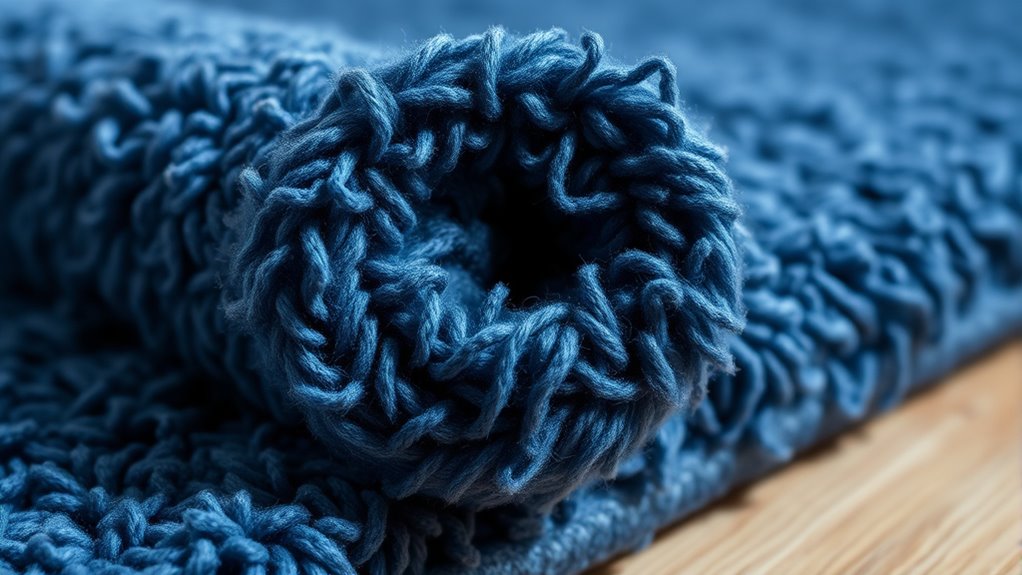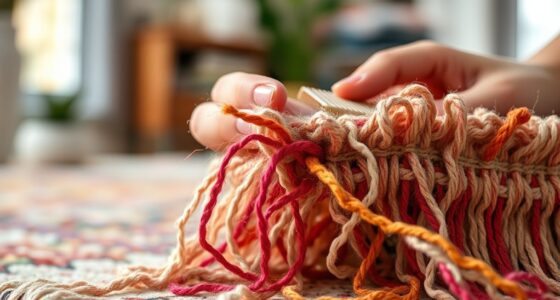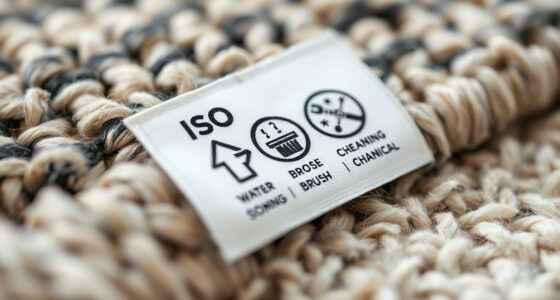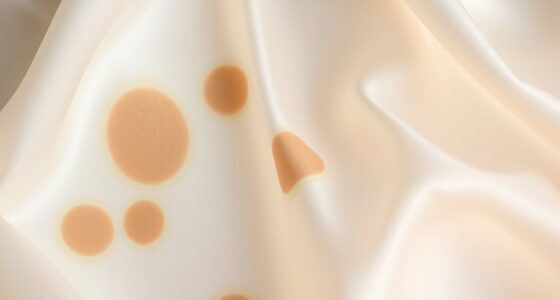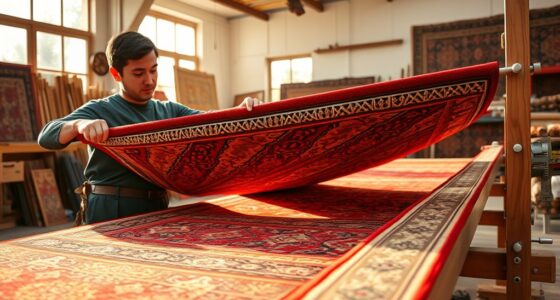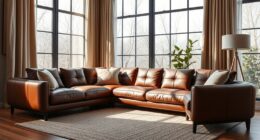If your rug corners are curling, it’s often due to poor material quality, improper placement, or environmental factors like humidity. Thin fibers, lightweight backing, and low-quality dyes weaken edges and cause lifting. To fix this, try gently pressing or weighting the corners, using double-sided tape, or improving padding support. Maintaining a stable indoor climate and ensuring proper rug care can prevent future curling. Keep exploring to discover more effective solutions for flat, neat rug corners.
Key Takeaways
- Rug corners often curl due to material weaknesses, such as thin fibers, inferior dyes, or poor weaving techniques.
- Proper backing, heavier pile, and quality materials help maintain rug flatness and prevent curling.
- Environmental factors like humidity fluctuations and temperature changes cause fibers to expand or contract, leading to curling.
- Securing the rug with padding, weights, or proper placement reduces edge lifting and maintains shape.
- Regular maintenance, gentle cleaning, and trimming frayed edges help prevent and correct curled corners.
Common Reasons Why Rug Corners Curl

Rug corners often curl due to a variety of common issues that can be easily addressed. One key factor is rug material selection; some materials, like wool or synthetic fibers, tend to curl more easily than others, especially if they’re thin or lightweight. Improper backing or lack of grip can also contribute to curling, as the rug lacks stability on the floor. Additionally, poor rug color coordination with your space might lead you to choose a rug that doesn’t sit flat—lighter shades or reflective dyes can sometimes cause uneven wear or curling over time. Recognizing these factors helps you pick the right rug material and color scheme, reducing the chances of corners curling. Proper choice and placement are essential for maintaining a flat, stylish rug. Understanding rug materials can help you select options that are less prone to curling and more durable over time. Using rug pads or grippers can provide additional stability and keep the corners firmly in place, and choosing the right rug size and shape can also influence how well the rug stays flat on your floor. To further minimize curling, selecting a rug with a heavier weight or thicker pile can improve its ability to lie flat and resist curling over time.
The Impact of Low-Quality Rug Materials
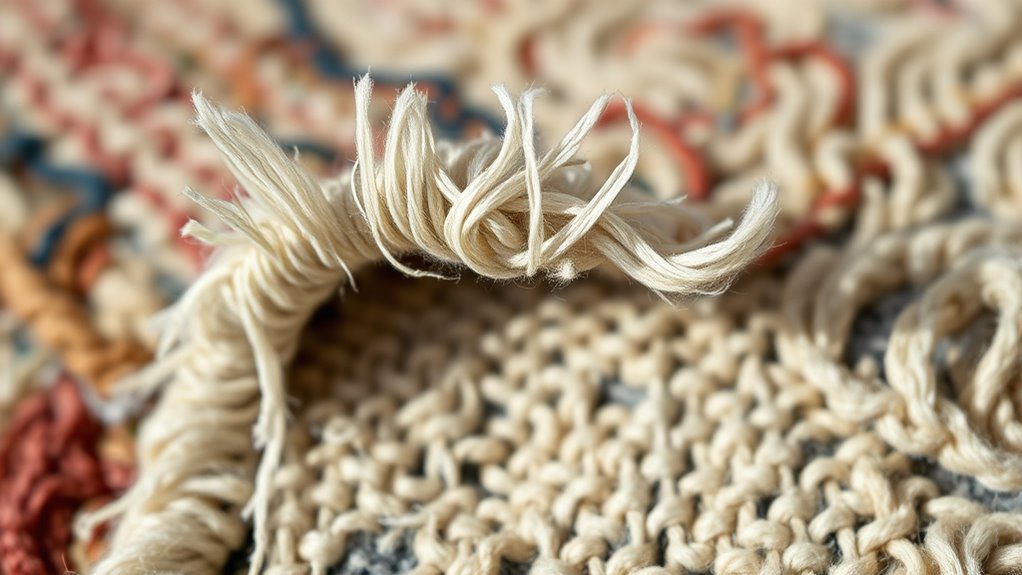
Low-quality rug materials markedly contribute to corners curling over time. When the rug material quality is poor, the fibers lack durability, causing the edges to lift and curl. This happens because low fiber durability can’t withstand regular foot traffic or cleaning, weakening the rug’s structure. To understand this better, consider:
- Thin or flimsy backing material that offers little support
- Fibers made from cheap synthetic fibers prone to fraying
- Poor weaving techniques that compromise overall strength
- Use of subpar dyes that weaken fiber integrity
- Proper material selection plays a crucial role in preventing curling and extending the rug’s lifespan. Additionally, the artistic influence of high-quality materials ensures the rug maintains its shape and appearance over time. Incorporating durable fibers can significantly improve the rug’s resilience against curling and wear. Recognizing the importance of fiber durability is essential for long-lasting rugs that resist curling.
Effects of Improper Rug Placement and Use
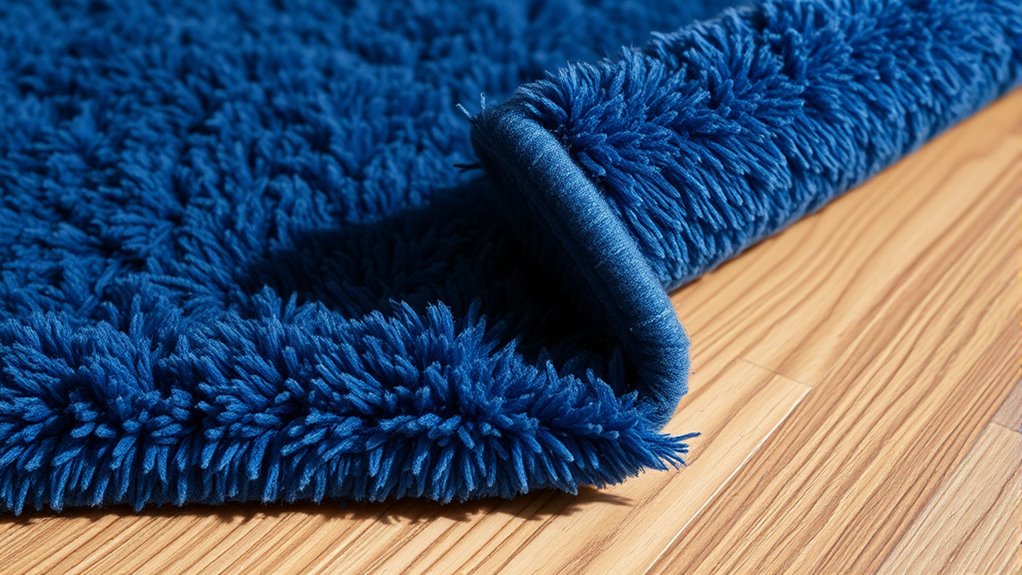
If you don’t place your rug properly, it can become a tripping hazard for everyone in your home. Over time, poorly positioned rugs can cause damage to their edges, making the curl worse. Paying attention to placement helps keep your space safe and your rug looking good. Implementing proper placement techniques can also prevent unnecessary wear and prolong the life of your rug.
Tripping Hazards Increase
Improper rug placement can substantially increase tripping hazards around your home. When rugs aren’t secure, they can slip or fold, creating dangerous bumps. To improve home safety and maintain your area rug, consider these tips:
- Ensure edges lie flat to prevent curling and folding.
- Use non-slip pads underneath rugs for better grip.
- Regularly check for loose corners or wrinkles during area rug maintenance.
- Avoid placing rugs in high-traffic areas without proper securing measures.
- Choosing safe and secure rug materials can also help reduce accidents and ensure longevity of your rug. Additionally, selecting rugs with anti-slip backing can further enhance stability and safety. Incorporating industry best practices for rug placement can significantly minimize risks and promote a safer environment. Proper rug placement not only enhances safety but also reduces the risk of damage caused by improper use, which can be linked to the importance of sustainable practices in maintaining home environments.
These steps help reduce tripping risks and keep your space safe. Remember, a well-maintained rug not only looks good but also contributes to overall home safety by minimizing hazards. Taking proactive measures now can prevent accidents and create a safer environment for everyone.
Damage to Rug Edges
When rugs are not placed or maintained properly, their edges are more likely to become damaged over time. Improper placement can cause curling, fraying, or tearing, especially if heavy furniture or foot traffic repeatedly stress the edges. Poor cleaning techniques may also weaken rug fibers, accelerating damage. To prevent this, choose rug designs with durable edges and use gentle cleaning methods. Regularly inspect your rug’s borders and fix curled corners early. Properly securing edges with rug tape or binding can also help maintain shape. Additionally, understanding rug construction can assist in selecting more resilient options. Knowing the types of rug materials can help in choosing fibers that resist wear and damage. Staying aware of AI in entertainment innovations can also inspire creative approaches to rug design and maintenance. Here’s a quick comparison:
| Issue | Solution |
|---|---|
| Fraying edges | Use edge binding or tape |
| Curling corners | Secure with rug tape or weights |
| Fiber wear | Gentle cleaning techniques |
| Design flaws | Select rugs with reinforced edges |
| Overall damage | Proper placement and maintenance |
Consistent care protects your rug’s appearance and longevity, and adopting preventive measures can further extend its lifespan.
How Humidity and Climate Affect Rug Edges

Humidity levels can cause your rug fibers to expand or contract, impacting the edges over time. Climate fluctuations throughout the year lead to seasonal moisture changes that may make corners curl or lift. Understanding how these environmental factors influence your rug helps you protect it effectively. Additionally, proper maintenance practices can help mitigate damage caused by humidity and climate variations. Cultivating awareness of these environmental influences can empower you to take proactive measures for your rug’s longevity. Considering the material composition of your rug can also guide you in choosing appropriate storage and cleaning methods to prevent curling. Recognizing how tuning influences vehicle performance can also provide insights into maintaining your vehicle’s optimal condition and preventing issues related to environmental stressors.
Humidity’s Impact on Fibers
Higher humidity levels can cause rug fibers, especially along the edges, to absorb moisture and expand. This fiber swelling results from humidity effects that make fibers more pliable and prone to curling. To manage this, consider these points:
- Increased moisture can weaken rug fibers, leading to uneven edges.
- Humidity causes fibers to swell, making corners curl upward.
- Consistent high humidity accelerates fiber deterioration over time.
- Proper ventilation helps reduce moisture buildup, minimizing fiber swelling.
- Using appropriate cleaning and maintenance techniques can help prevent long-term damage.
- Implementing climate control methods can help regulate humidity levels and preserve your rug’s shape.
Understanding humidity’s role in fiber behavior helps you prevent and fix rug corner curls. By controlling moisture levels, you limit fiber swelling and maintain your rug’s shape. Regularly monitoring humidity and using dehumidifiers or fans can make a significant difference in preserving your rug’s edges.
Climate Fluctuations and Edges
Climate fluctuations, including shifts in temperature and humidity levels, directly impact the condition of your rug edges. When the air becomes drier or more humid, your rug may experience matting issues, causing the edges to curl or fray. These changes can weaken the fibers, making your rug more susceptible to damage and uneven wear. Aesthetic concerns also arise, as curled or frayed edges detract from your rug’s appearance. Sudden temperature swings can cause expansion and contraction in the fibers, worsening the curl and making repairs more challenging. To minimize these effects, maintain a consistent indoor climate with controlled humidity levels. Doing so helps preserve your rug’s edges, keeping them looking neat and preventing further damage caused by climate-related fluctuations.
Seasonal Moisture Changes
As seasons change, fluctuations in moisture levels can particularly impact your rug edges. Increased seasonal moisture causes rug fiber expansion, leading to curled corners. Conversely, dry seasons cause fibers to contract and flatten, which may also trigger curling. To minimize these effects, consider:
- Using a dehumidifier during humid months to control seasonal moisture.
- Keeping your home at a consistent humidity level.
- Avoiding excessive exposure to direct sunlight, which accelerates fiber expansion.
- Regularly rotating your rug to distribute wear and moisture effects evenly.
Understanding how humidity and climate influence rug fiber expansion helps you prevent and fix corner curls. Managing seasonal moisture levels ensures your rug maintains its shape and longevity, keeping edges flat and secure despite climate changes.
The Role of Inadequate Rug Padding
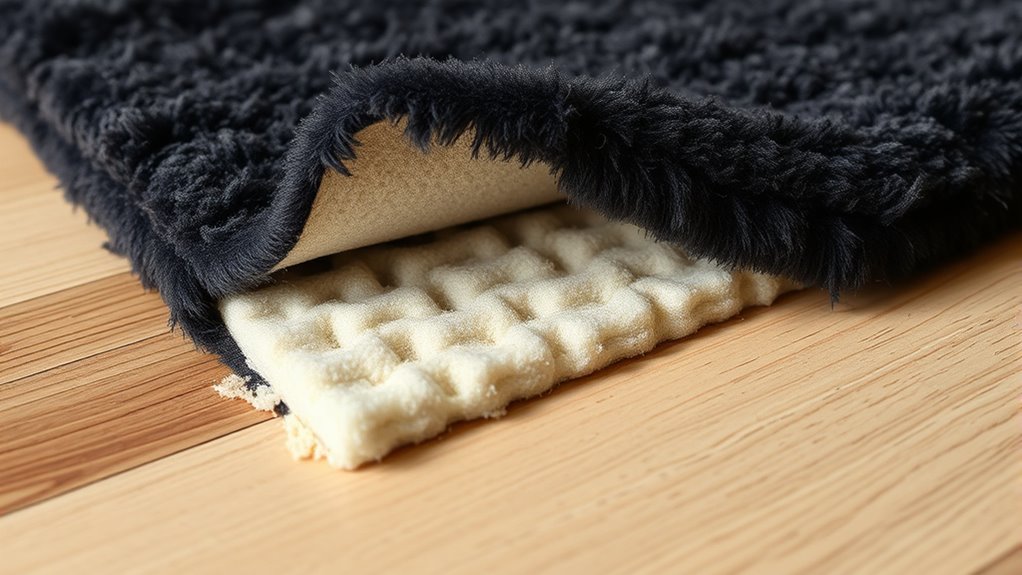
Inadequate rug padding often plays a significant role in causing rug corners to curl upward. When your rug lacks sufficient cushion thickness, it doesn’t stay flat against the floor, making edges prone to curling. Thin or worn-out rug padding provides minimal support, allowing the rug’s fibers to lift over time. Without proper padding, the rug can shift or bunch, especially at the corners, leading to curling and an uneven appearance. Using the right rug padding with adequate cushion thickness helps anchor the rug securely to the floor, reducing movement and upward curl. It also distributes weight evenly, preventing stress on the edges. Investing in quality padding is essential for maintaining a flat, neat look and preventing corners from curling over time.
Techniques for Flattening Curling Corners
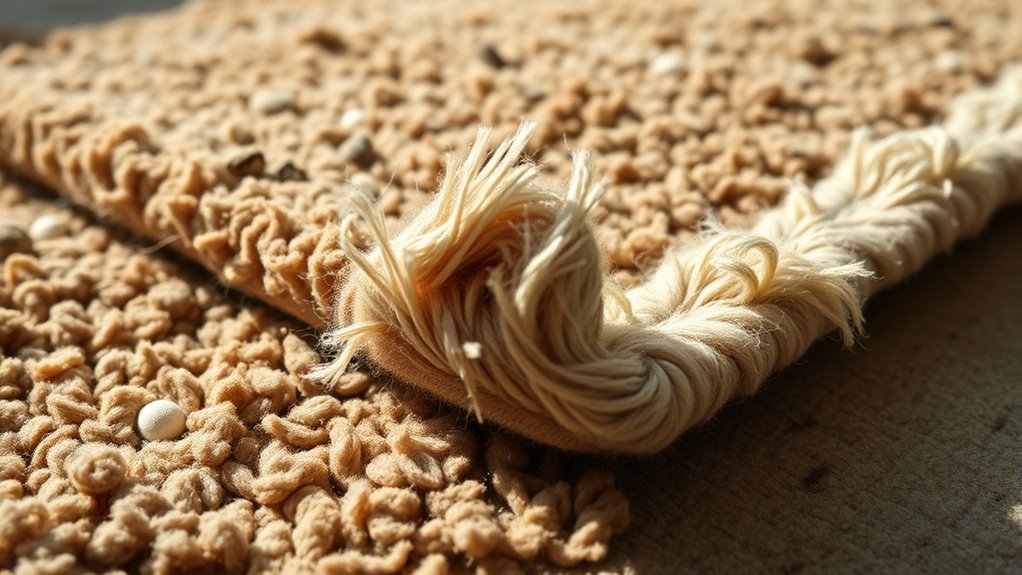
To effectively flatten curling rug corners, you can employ simple yet effective techniques that encourage the fibers to lie flat again. First, smooth out the corner gently with your hand, pressing down firmly. Second, use weights or heavy books on the curled edges for a few hours to encourage flattening. Third, adjust your rug pad to ensure compatibility and prevent future curling; a well-fitting rug pad provides proper support. Fourth, consider trimming decorative fringe if it’s causing uneven tension, which can contribute to curls. These methods help realign fibers and improve the rug’s shape. Remember, patience is key, and combining these techniques often yields the best results for flat, smooth corners.
Using Heat and Moisture to Relax Rug Fibers

Applying heat and moisture can effectively relax curled rug fibers, making it easier to reshape the corners. When you use heat application, it softens the fibers, allowing them to become more pliable for fiber relaxation. Lightly mist the back of the rug with water or a mixture of water and mild detergent, then apply gentle heat using a hairdryer set on low or medium. Keep the dryer moving to distribute heat evenly and prevent damage. The combination of moisture and warmth loosens the fibers, reducing curl and encouraging the rug to lay flat. Be cautious not to overheat or oversaturate, as excessive heat or moisture can harm the rug fibers. This method offers a quick, effective way to address rug corner curl through controlled fiber relaxation.
Applying Double-Sided Tape or Rug Grippers
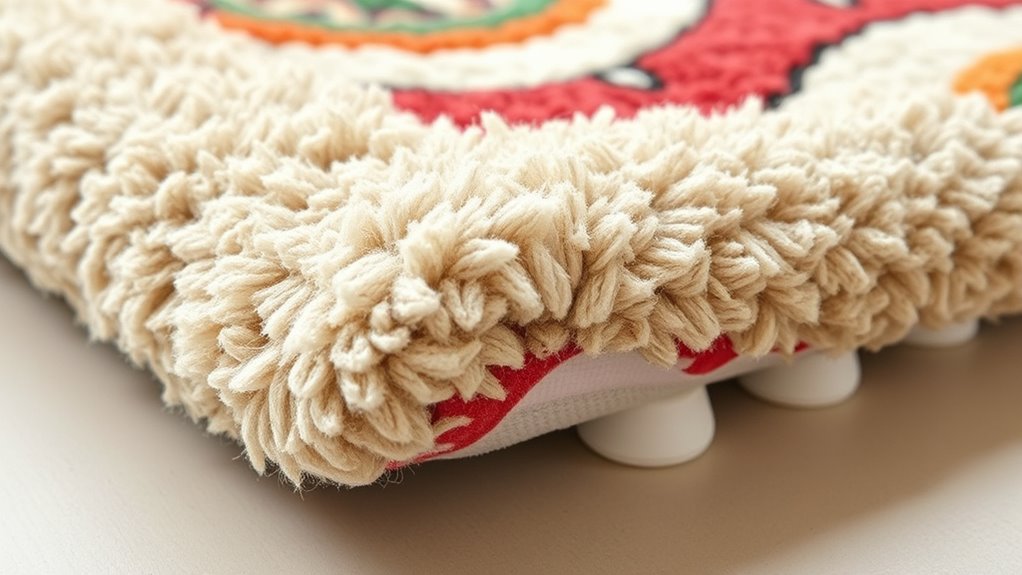
Using double-sided tape or rug grippers is an effective way to secure rug corners and prevent curling from shifting or lifting. First, clean the area beneath the rug to assure good adhesion. Second, cut strips of double-sided tape or attach rug grippers to the underside of each corner. Third, press firmly to secure the tape or grippers, making sure they stick well. Fourth, smooth out the edges to prevent any bumps or wrinkles. Double-sided tape offers a quick, inexpensive fix, while rug grippers provide a more durable hold. Both options keep your rug flat and prevent edges from curling up. Make sure to check and replace the adhesive periodically for continued effectiveness. This simple step can dramatically improve your rug’s appearance and safety.
Preventative Tips to Keep Rug Corners Flat

Preventing rug corners from curling starts with proper placement and maintenance. Regular rug cleaning removes dirt and debris that can cause uneven wear, helping the rug stay flat longer. Make sure your rug is positioned on a clean, smooth surface to prevent shifting. Correct furniture placement also plays a key role; heavy furniture can help anchor corners and keep them flat. Avoid placing lightweight furniture that might slide or cause the rug to lift at the edges. Additionally, rotate your rug periodically to ensure even wear and prevent one corner from curling more than others. Using furniture strategically and maintaining a clean, well-kept rug reduces the likelihood of curled corners, keeping your rug looking neat and flat over time.
Frequently Asked Questions
Can Outdoor Weather Conditions Cause Rug Corners to Curl?
Outdoor weather conditions can definitely cause rug corners to curl, especially if your rug is positioned near open windows or doors. Changes in indoor humidity from outdoor moisture can loosen the rug’s fibers, making corners lift. To prevent this, verify proper rug placement away from drafts, and maintain consistent indoor humidity levels. Regularly adjusting your rug’s position and using rug pads can also help keep corners flat and secure.
Is It Safe to Use Household Tools for Fixing Curled Rug Edges?
While DIY repairs seem straightforward, you shouldn’t always rely on household tools for fixing curled rug edges. Using household tool safety is vital; not all tools are designed for delicate rug fibers. You might risk damaging your rug further or injuring yourself. Instead, consider professional fixes or specialized tools, especially if you’re uncertain. Prioritize safety and precision to guarantee your rug stays beautiful without unintended damage.
How Often Should I Inspect My Rug for Signs of Curling?
You should inspect your rug regularly as part of routine rug maintenance. Aim for an inspection frequency of at least once a month, especially in high-traffic areas or if you notice any signs of curling or uneven edges. Frequent checks help you catch issues early, allowing you to address curled corners promptly before they worsen. Consistent inspection preserves your rug’s appearance and extends its lifespan.
Do Certain Rug Shapes or Sizes Tend to Curl More Than Others?
Certain rug shapes and sizes do tend to curl more than others. Rug shape stability plays a role—irregular or rounded shapes often experience more curl than rectangular or square rugs. Additionally, rug size influence is significant; larger rugs are more prone to curling because of increased surface area and weight distribution. To prevent this, guarantee proper stretching and use rug pads, especially for bigger or uniquely shaped rugs, to maintain their flatness.
Can Regular Cleaning Prevent Rug Corners From Curling Over Time?
Imagine your rug’s corners as tiny guardians of comfort—keeping them in place is essential. Regular cleaning techniques, tailored to your rug material, help prevent curling by removing dirt and moisture that cause edges to lift. Proper maintenance keeps your rug looking fresh and ensures these corners stay flat and inviting. So, yes, consistent cleaning can be a simple yet powerful way to protect your rug’s shape and longevity.
Conclusion
To keep your rug corners lying flat like loyal guardians at your home’s entrance, address the root causes and use simple fixes. Regularly check your rug’s placement, invest in quality materials, and use proper padding. Think of your rug as a story unfolding—if you don’t smooth out the wrinkles, the story loses its charm. With a little care and attention, your rug will stay pristine, anchoring your space with effortless elegance.
